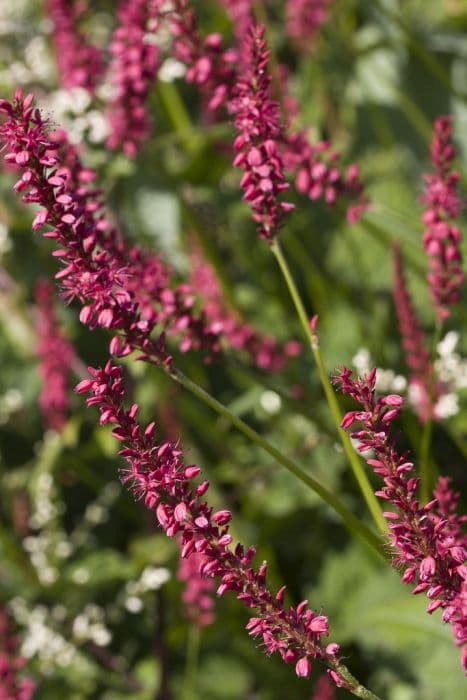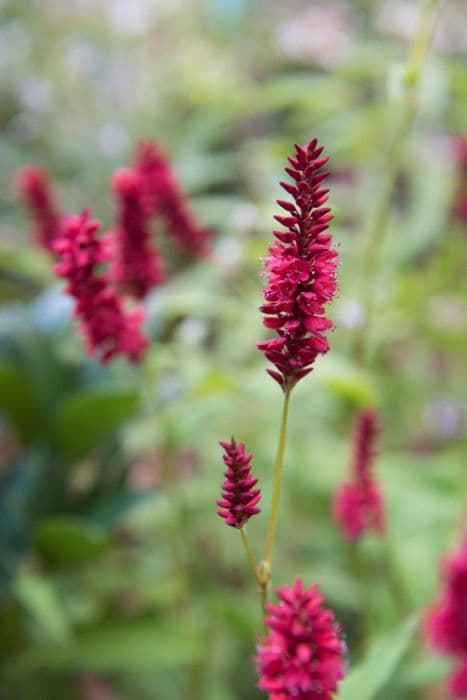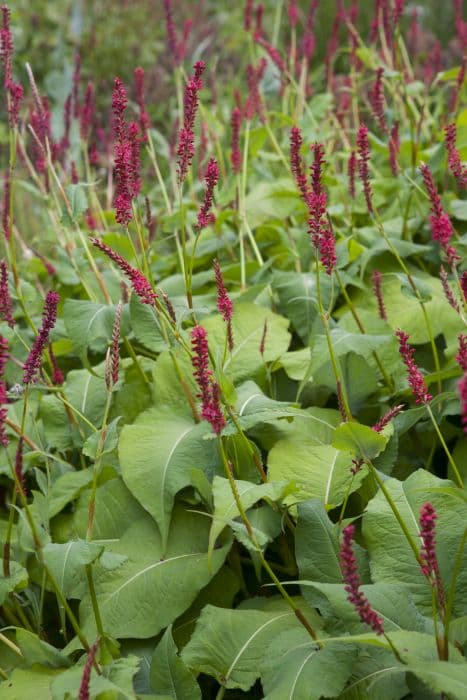Bistort Persicaria bistorta 'Superba'

ABOUT
The Persicaria bistorta 'Superba', commonly known as Bistort 'Superba', boasts a beautiful display of pink flower spikes. These bottlebrush-like blooms stand proudly above the foliage, attracting attention with their dense, elongated clusters. The flowers offer a soft pink hue that adds a delicate touch to gardens when they blossom in the warmer months. The leaves of the Bistort 'Superba' are a notable feature in their own right. They present as large, green, and leathery with a slightly puckered texture. These leaves are shaped like elongated hearts, curving gracefully at the edges, and provide a lush backdrop to the charming flowers. The plant's overall form creates a clump of foliage and flowers that tend to have an arching and spreading habit. This gives Bistort 'Superba' a full and robust appearance, making it a favorite for borders or as ground cover. The visual impact of this plant is one of soft textures, with the contrast between the dense flower spikes and the broad leaves offering a harmonious and elegant display in any garden setting.
About this plant
 Names
NamesFamily
Polygonaceae.
Synonyms
Bistort, Snakeweed, Easter-ledges, Adderwort, Dragonwort, Osterick, Passions, Patience Dock, Red Legs, Twice Writhen, Water-Ledger.
Common names
Persicaria bistorta, Polygonum bistorta, Bistorta major, Bistorta officinalis.
 Toxicity
ToxicityTo humans
Bistort (Persicaria bistorta 'Superba') is not commonly known to be toxic to humans. There are no significant reports of poisoning or toxic reactions from ingesting this plant. However, as with any plant, some individuals might experience an allergic reaction or mild stomach upset if they consume parts of the plant, particularly if they are not used to eating it.
To pets
Bistort is also not known to be toxic to pets. While it is not common for pets to ingest this plant, there is no widespread evidence to suggest that it would cause them significant harm. As with humans, the biggest risk would be the potential for an allergic reaction or gastrointestinal discomfort if a pet were to eat a large amount of the plant.
 Characteristics
CharacteristicsLife cycle
Perennials
Foliage type
Deciduous
Color of leaves
Green
Flower color
Pink
Height
2 feet (0.61 meters)
Spread
2 feet (0.61 meters)
Plant type
Herb
Hardiness zones
3
Native area
Europe
Benefits
 General Benefits
General Benefits- Attracts Pollinators: Persicaria bistorta 'Superba', commonly known as Bistort, is attractive to bees, butterflies and other pollinating insects, which support biodiversity in the garden.
- Erosion Control: The plant's dense growth habit can help stabilize soil and prevent erosion on slopes and banks.
- Low Maintenance: Bistort is known for being a low-maintenance plant, requiring minimal care once established in an appropriate location.
- Drought Tolerance: Once established, the plant can tolerate periods of dryness, making it suitable for gardens with less frequent watering.
- Aesthetic Appeal: With its lush foliage and pink spike-shaped flowers, Bistort adds ornamental value to gardens and landscapes.
- Long Blooming: The plant has a long flowering period from late spring to early summer, offering extended visual interest.
- Wildlife Habitat: Bistort provides a habitat and food source for a variety of wildlife including insects and birds.
- Seasonal Interest: Its foliage often turns attractive colors in the fall, providing seasonal interest in the garden.
- Easy Propagation: Bistort can easily be propagated by division, allowing gardeners to expand their plantings or share with others.
- Ground Cover: Its spreading nature makes it an effective ground cover, suppressing weeds and covering bare spots in the landscape.
 Medical Properties
Medical Properties- Anti-inflammatory: Persicaria bistorta 'Superba', commonly known as Bistort, has been traditionally used for its anti-inflammatory properties to help reduce swelling and inflammation.
- Astringent: The plant has historically been used for its astringent qualities which can help tighten tissues and reduce secretions.
- Gastrointestinal aid: Bistort has been used in herbal medicine to support gastrointestinal health and to treat issues such as diarrhea and dysentery.
- Antiseptic: Due to its potential antiseptic properties, Bistort has been used to clean wounds and prevent infection.
- Hemostatic: The plant's hemostatic (blood-stopping) capabilities make it useful in traditional medicine for stopping bleeding, both internally and externally.
- Mouthwash: Bistort has been used in the past as a mouthwash to treat issues such as gum infections and mouth ulcers due to its astringent and antiseptic properties.
 Air-purifying Qualities
Air-purifying QualitiesThis plant is not specifically known for air purifying qualities.
 Other Uses
Other Uses- Persicaria bistorta 'Superba', or bistort, can be used in floral arrangements for its showy, pink flower spikes that add height and texture to bouquets.
- The dried flower spikes of bistort can serve as a natural dye for fabrics, imparting subtle shades of pink or brown depending on the mordant used.
- In garden design, bistort can be used to create a 'naturalistic' look, blending well with grasses and other perennials in meadow-style plantings.
- The plant's dense clumps are useful in controlling soil erosion, making it a practical choice for slopes and banks.
- Bistort can be incorporated into wildlife gardens, as it provides nectar for pollinators, including bees and butterflies.
- The leaves can be used in compost as a 'green' layer, contributing nitrogen to the composting process.
- In ponds or water garden features, bistort can grow at the water's edge, providing habitat and hiding spots for amphibians and insects.
- The winter seed heads of bistort can offer visual interest in the garden during the colder months and can also be used for winter floral displays.
- As a ground cover plant in shaded areas, bistort can suppress weeds while still allowing bulbs and small perennials to emerge through its foliage.
- Bistort's dense growth habit can be useful for creating a vegetative border or low hedge along walkways or garden paths.
Interesting Facts
 Feng Shui
Feng ShuiThe Bistort is not used in Feng Shui practice.
 Zodiac Sign Compitability
Zodiac Sign CompitabilityThe Bistort is not used in astrology practice.
 Plant Symbolism
Plant Symbolism- Healing: Persicaria bistorta, commonly known as Bistort, has historically been used for its medicinal properties, suggesting a symbolic connection to healing and health.
- Resilience: Bistort's ability to thrive in various conditions and its vigorous growth habit symbolizes resilience and adaptability.
- Femininity: The soft pink spikes of the Bistort flowers are often associated with feminine energy and grace.
- Connection to Nature: As a plant that is found in meadows and natural settings, Bistort symbolizes a strong connection to the earth and nature's cycles.
- Prosperity: In some traditions, due to its lush and abundant flowering, Bistort can represent prosperity and abundance.
 Water
WaterBistorta, commonly known as Snakeweed, prefers consistently moist soil, so it requires regular watering, particularly during dry spells. It’s best to water deeply once a week, providing the plant with about 1 to 1.5 inches of water. This roughly translates to about 0.6 gallons per square yard per week, assuming minimal rainfall. During particularly hot or windy weather, you may need to increase the frequency to keep the soil from drying out. Always water at the base of the plant to avoid wetting the foliage, which can lead to fungal diseases.
 Light
LightSnakeweed thrives in full sunlight to partial shade. The ideal spot for this plant is one where it can receive at least four to six hours of sunlight every day. Too much shade can lead to leggy growth and fewer flowers, whereas too much direct sun in very hot climates may require additional watering to prevent stress.
 Temperature
TemperatureSnakeweed is hardy and can tolerate a wide range of temperatures, from a minimum of -20 degrees Fahrenheit to a maximum of around 90 degrees Fahrenheit. The ideal temperature for robust growth and flowering lies between 60 and 75 degrees Fahrenheit. Snakeweed is resilient and can survive a frost, which is beneficial for gardeners in areas with unpredictable spring weather.
 Pruning
PruningPruning Snakeweed helps maintain a neat appearance and encourages more prolific blooming. It’s best to prune in late winter or early spring before new growth begins. Cut back the old stems to about 3-6 inches above the ground to promote fresh growth. You can also deadhead spent flowers during the blooming season to encourage more flowers. Regular pruning, at least once a year, will help prevent the plant from becoming woody and overgrown.
 Cleaning
CleaningAs needed
 Soil
SoilThe best soil mix for the plant commonly known as Bistort or Snakeweed should be rich and moist but well-draining, comprising a mix of garden soil, compost, and some sand to ensure proper drainage. The ideal pH range for Bistort is between 5.5 and 7.0, slightly acidic to neutral.
 Repotting
RepottingBistort typically doesn't require frequent repotting and can be repotted every 2-3 years or when it outgrows its current container. It's a hardy perennial that can spread in the garden if not contained.
 Humidity & Misting
Humidity & MistingBistort thrives in moderate to high humidity levels but is quite adaptable and can tolerate the lower humidity levels commonly found in a home environment.
 Suitable locations
Suitable locationsIndoor
Place Bistort in bright, indirect light and ensure moist soil.
Outdoor
Plant in sun or partial shade, and keep soil consistently moist.
Hardiness zone
4-9 USDA
 Life cycle
Life cycleBistort 'Superba' (Persicaria bistorta 'Superba') begins its life cycle as a seed, germinating in fertile, moist soil in spring. Once germinated, it sends up sprouts which develop into a rosette of leaves; the plant’s perennial nature means that it will re-emerge from its rootstock every year. As the plant matures, it produces tall, erect flower spikes with densely packed pink flowers by late spring or early summer. After flowering, seed production follows, and seeds disperse to propagate the next generation. In autumn, the plant's above-ground parts die back, with the rootstock surviving through winter to repeat the cycle. During its life, the bistort can also spread vegetatively through its rhizomes, creating a clump that expands gradually over the years.
 Propogation
PropogationPropogation time
Spring-Early Summer
The most popular method for propagating Bistort 'Superba' is through division, which is best done in the spring. To propagate by division, carefully dig up the entire plant, making sure to keep the root ball intact. Then, using a sharp knife or spade, divide the root ball into smaller sections, ensuring that each section has a portion of the roots and at least one shoot. Replant the divisions at the same depth they were growing at before and water them well. It is important to keep the soil moist until the new plants have established, which typically takes a few weeks. This simple yet effective form of propagation helps to maintain the vigor of the plant and can be used to produce several new plants from a single mature specimen.









